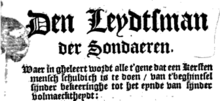Philip Numan
Philip Numan (born around 1550, died 19 February 1627) was a Flemish lawyer and humanist, a writer in prose and verse, sometimes under the pen name Hippophilus Neander.[1]
Philip Numan | |
|---|---|
 Part of the frontispiece to Den Leydtsman der Sondaren, Numan's translation of a work by Luis de Granada | |
| Born | around 1550 Brussels |
| Died | 19 February 1627 Brussels |
| Pen name | Hippophilus Neander |
| Occupation | secretary to the city of Brussels |
| Language | Dutch, French, Latin |
| Nationality | Duchy of Brabant |
| Citizenship | Brussels |
| Period | Baroque |
Life
Numan was appointed city secretary of Brussels in 1583, and planned the joyous entries into the city of Archduke Ernest of Austria in 1594 and of Albert VII, Archduke of Austria in 1596.[2]
His account of the miracles attributed to the intercession of the local cult of Our Lady of Scherpenheuvel was published in Dutch and French, and soon translated into Spanish and English.[3]
He translated a number of Latin and Spanish works into Dutch (and in one case into French). When he was translating Diva Virgo Hallensis by Justus Lipsius, Lipsius wrote to him on 9 April 1605 that he should not translate too literally, but in his own natural style, because "each language has its own character and as it were its own genius, which cannot be conveyed in another language".[4] In preliminary verses to Richard Verstegan's Neder-duytsche epigrammen (Mechelen, Henry Jaye, 1617) Numan wrote in praise of the "genius" of Dutch as a literary language.[5][6]
Works
As author
- Den Spiegel der Menschen, innehoudende den generalen staet ende roep van t'menschelijck gheslachte. Antwerp, Hans Coesmans, 1583.
- Den Strijt des gemoets inden wech der deuchden. Brussels, Jan Mommaert, 1590.
- Descriptio Spectaculorum et Ludorum in adventu Sereniss. Principis Ernesti Austriaci Bruxellis editorum. Antwerp, Christopher Plantin, 1595. This work on a Joyous Entry of Archduke Ernest of Austria to Brussels was illustrated by Johannes Bochius and Joos de Momper.[7]
- Panegyricus in adventum serenissimorum principum, Alberti et Isabellae, Archiducum Austriae, Ducum Brabantiae, in civitatem Bruxellensem. Brussels, Jan Mommaert, 1599.
- Historie vande Mirakelen die onlancx in grooten getale gebeurt zyn, door die intercessie ende voor-bidden van die H. Maget Maria. Op een plaetse ghenoemt Scherpenheuvel by die stadt van Sichen in Brabandt. 2nd edition. Leuven, Jan Baptist Zangre, 1604. Further edition Brussels, Rutger Velpius, 1606. Augmented edition 1614.
- Histoire des Miracles advenuz n'agueres a l'intercession de la Glorieuse Vierge Marie, au lieu dit Mont-aigu, prez de Sichen, au Duché de Brabant. 2nd edition. Brussels, Rutger Velpius, 1605. Augmented edition 1613. On the Marian cult of the Basilica of Our Lady of Scherpenheuvel.
- Spanish translation as Historia de los Milagros que en Nuestra Señora de Monteagudo çerca de Sichen, en el Ducado de Brabante, nuestro Señor ha sido servido de obrar by Cæsar Clement. Brussels, Rutger Velpius, 1606.[8]
- English translation as Miracles lately wrought by the intercession of the Glorious Virgin Mary at Mont-aigu, nere unto Sichen in Brabant, by Robert Chambers[9] (Antwerp, Arnout Coninx, 1606)
- Toe-voechsele vanden Mirakelen gheschiedt op Scherpen-heuvel. Brussels, Hubert Anthoon, 1617.
- Ander mirakelen van onse lieve vrouwe op Scherpenheuvel. Brussels, Hubert Anthoon, 1617.
- Autres Miracles de Nostre Dame au Mont-Aigu. Brussels, Hubert Anthoon, 1618.
As translator
- Louis of Granada, Den Leydtsman der Sondaeren. Antwerp, Christopher Plantin, 1588. Further edition 1613.
- Raymond of Capua, Het Leven van de seer heylighe Maghet Catherina van Senen. Brussels, 1594. Reprinted Antwerp, 1638.
- Bernardino da Balbano, Theylich Mysterie van die Gheesselinghe ons Heeren Iesu Christi. Leuven, Jan Maes, 1607. Reprinted 1611.
- Justus Lipsius, Die Heylighe Maghet van Halle. Brussels, Rutger Velpius, 1607. Reprinted 1643.
- Andres de Soto, Deux dialogues traitans de la doctrine & matiere des miracles. Brussels, Rutger Velpius, 1613.
- Also into Dutch as Twee t'samensprekingen behandelende de leeringe ende materie vanden mirakelen. Brussels, Rutger Velpius, 1614.
Bibliography
- Aa, A.J. van der, Biographisch woordenboek der Nederlanden, volume 13, Haarlem, 1868, pp. 344–345
- Witsen Geysbeek, P.G., Biographisch anthologisch en critisch woordenboek der Nederduitsche dichters, volume 4, Amsterdam, 1822, p. 520
References
- Philip Numan, in K. ter Laan, Letterkundig woordenboek voor Noord en Zuid (2nd edition; The Hague and Jakarta, 1952).
- Katharina van Cauteren, Eight unknown designs by Hendrick de Clerck for Archduke Albert's entry into Brussels in 1596, Simiolus: Netherlands Quarterly for the History of Art Vol. 34, No. 1 (2009/2010), pp. 18–32, at p. 20. Published by: Stichting Nederlandse Kunsthistorische Publicaties. Stable URL: https://www.jstor.org/stable/20779988
- Jeanine De Landtsheer, "From Philip Numan’s Miracles of the Virgin of Montaigu (1604) towards Justus Lipsius's Diva Sichemiensis sive Aspricolis (1605)", in Texts beyond Borders: Multilingualism and Textual Scholarship, edited by Wout Dillen, Caroline Macé and Dirk Van Hulle (Variants 9; Amsterdam and New York, 2012), pp. 62-65.
- Erik De Bom, Geleerden en politiek: De politieke ideeën van Justus Lipsius in de vroegmoderne Nederlanden (Hilversum, 2011), p. 86.
- Brendan Maurice Dooley (2010). The Dissemination of News and the Emergence of Contemporaneity in Early Modern Europe. Ashgate Publishing, Ltd. p. 197. ISBN 978-0-7546-6466-6.
- Richard Verstegan, Neder-duytsche epigrammen (Mechelen, 1617), sig. [A6v].
- Margit Thøfner, Marrying the City, Mothering the Country: Gender and Visual Conventions in Johannes Bochius's Account of the Joyous Entry of the Archduke Albert and the Infanta Isabella into Antwerp, Oxford Art Journal Vol. 22, No. 1 (1999), pp. 3–27, at p. 13. Published by: Oxford University Press. Stable URL: https://www.jstor.org/stable/1360681
- Arblaster, Paul. "Clement, Caesar". Oxford Dictionary of National Biography (online ed.). Oxford University Press. doi:10.1093/ref:odnb/5601. (Subscription or UK public library membership required.)
- Arblaster, Paul. "Chambers, Robert". Oxford Dictionary of National Biography (online ed.). Oxford University Press. doi:10.1093/ref:odnb/5077. (Subscription or UK public library membership required.)